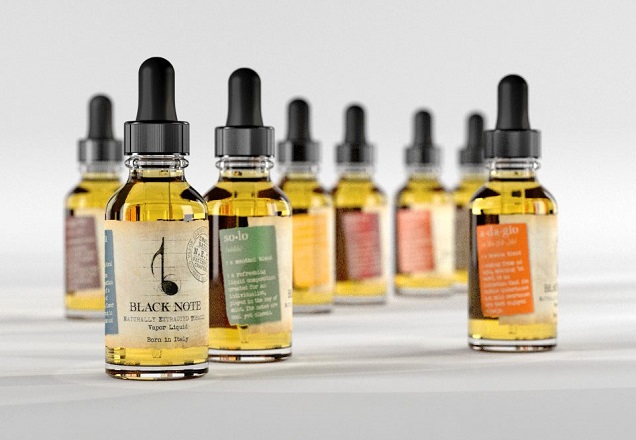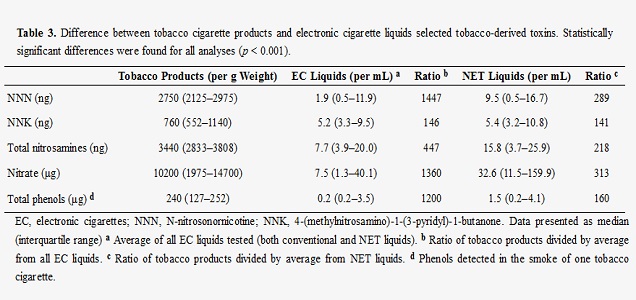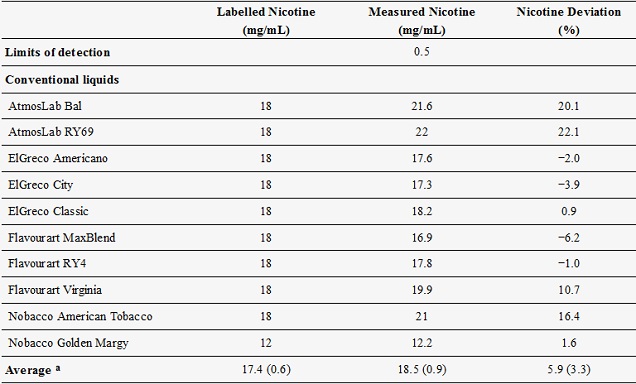
A new study from Dr. Konstantinos Farslinos and colleagues has provided further confirmation that e-cigarettes are vastly safer than cigarettes, including naturally-extracted tobacco (NET) e-liquids that use flavor directly extracted from tobacco leaves. A toxicological study conducted by the same group previously found that the NET e-liquids tested were more toxic to cells than ordinary e-liquids (although still much less so than tobacco e-liquids), but the new study suggests that, chemically speaking, the difference between naturally-extracted and ordinary tobacco e-liquids is negligible.
Among other groups of chemicals, this research looked at tobacco-specific nitrosamines (TSNAs) – one of the most potent carcinogens in cigarettes – and found that the average levels in all tested e-liquids are almost 450 times lower than in tobacco, and Naturally Extracted Tobacco e-liquids specifically contain over 200 times lower levels.
The Results at a Glance:
- Total nitrosamine levels in ordinary e-liquid were an average of 6.1 nanograms (ng) per ml (around 6 parts per billion) in comparison to 15.8 ng per ml (16 parts per billion) for NET e-liquids.
- All e-liquids averaged together had 447 less nitrosamines than tobacco.
- Phenol levels were 1,200 times lower on average per ml of tested e-liquids in comparison to in the smoke of 1 cigarette.
- NET e-liquids had more phenols than conventional liquids, but still 160 times lower than in tobacco.
- Levels of nitrates were 1,360 times lower per ml of e-liquid (all liquids averaged together) than in each gram of tobacco.
- NET e-liquids had more nitrates than conventional ones, but still 313 times less than tobacco.
- Average formaldehyde content measured in the liquid was 2.3 μg per ml for conventional and 3.2 μg per ml for NET liquids. However, more aldehydes are produced when the liquid is converted to vapor, which wasn’t tested here.
- For conventional e-liquids, nicotine deviated from the stated value by just 5.9 percent on average, and for Naturally Extracted Tobacco e-liquids it was just 1.5 percent. More than half of all tested e-liquids deviated by less than 10 percent, within the standard for medicinal products.
The Study – Comparing NET and Ordinary E-Liquids for Harmful Chemicals
The study (available in full for free) had a pretty straightforward design: get a bunch of e-liquids and test them for the presence of TSNAs, nicotine content (looking at accuracy of labeling), nitrates, phenols, formaldehyde and acetaldehyde. The researchers obtained 21 different tobacco e-liquids, 11 of which used NET for the flavor and 10 used more conventional flavorings. Of course, the levels found in e-liquids were compared with those obtained in other studies for combustible tobacco.
It’s worth noting that these tests were conducted on e-liquids rather than the vapor produced from them. While some formaldehyde and acetaldehyde are produced when e-liquids are heated (tiny amounts in ordinary usage conditions, but more during “dry puffs”), TSNAs and other chemicals come from the process of obtaining nicotine from tobacco, and will be present in the e-liquid as well as the vapor – this is why they’re also found in pharmaceutical nicotine products. So while the aldehyde content found here is probably an underestimate, the majority of the chemicals examined should be present in similar quantities in the liquid and the vapor – although further studies will be needed to confirm this.
What They Found – E-Cigarettes are Vastly Safer than Tobacco Cigarettes

The researchers report that, overall, the levels of harmful chemicals and common tobacco toxins in e-liquids are hundreds to over a thousand times lower than those in conventional tobacco products.
Nitrosamine Levels in Naturally Extracted Tobacco and Conventional E-Liquids
Levels of tobacco-specific nitrosamines are one of the primary concerns in e-liquid, but – as in all previous studies looking for them – only trace levels were detected. Overall, nitrosamine levels in ordinary e-liquids were lower than in NET e-liquids, but the difference was not statistically significant. In ordinary e-liquids, the average total nitrosamine content was 6.1 nanograms (ng) per ml, which is roughly just six parts per billion, and for NET e-liquids it was 15.8 ng per ml, or around 16 parts per billion. In comparison, nicotine patches contain around 8 ng per patch.
The overall difference between conventional and NET liquids might seem fairly large (don’t forget, though, we’re dealing with tiny amounts here), but the variation between individual liquids was pretty big – from a minimum detected of 1.7 ng per ml to a maximum of 22.4 ng per ml (both of these in conventional liquids, no less) – and this is taken into account when working out statistical significance.
In comparison to tobacco, the levels of nitrosamines in e-liquids really are very tiny. For both nitrosamines tested in the study (NNN and NNK) put together, the average for all tested e-liquids (both NET and ordinary) was 447 times less than that for tobacco and the NET e-liquids specifically contained 218 times less. The largest difference observed was for NNN between tobacco and the average of all e-liquids, where combusted tobacco contained 1,447 times more than e-liquids, and the smallest difference was for NNK between tobacco and NET e-liquid, but here tobacco still had 141 times more per gram than e-liquids did per ml. In brief: the nitrosamine content of e-liquids is absolutely negligible.
Nitrates, Phenols and Aldehydes in NET and Conventional E-Liquids
For nitrates, there was a difference between Naturally Extracted Tobacco e-liquids and conventional e-liquids, with only two conventional e-liquids having detectable nitrate levels in comparison to nine of the 11 NET e-liquids. The average for the NET e-liquids was still very small, though, at 32.6 μg (millionths of a gram) of nitrate per ml, making it just under 33 parts per million. Even for the NET e-liquids, the levels were 313 times lower than are present in tobacco, and for all e-liquids combined the levels were 1,360 times lower than in tobacco.
For phenols, there were small amounts detected in nine e-liquid samples, with seven of these being NET e-liquids. Taking all the phenols together, the NET e-liquids had 1.5 μg per ml, in comparison to 0.2 μg per ml for the conventional e-liquids – again, this shows a trend but didn’t reach statistical significance. In cigarettes, phenols are produced from the heating of chemicals naturally present in the plant, so in this case the levels were compared with smoke rather than tobacco. The authors found that for all e-liquids averaged together, levels in 1 ml of liquid were 1,200 times lower than that that present in the smoke of one cigarette, and for NET e-liquids, they were present in 160 times lower quantities.
For acetaldehyde and formaldehyde, there was little difference between NET and conventional e-liquids. Acetaldehyde was actually detected more often in conventional samples, and too few of the NET e-liquids contained it (just three) in detectable quantities to produce a reliable average. Formaldehyde was more common, but the levels were very similar between types (2.3 vs. 3.2 μg per ml for conventional vs. NET liquids).
Accuracy of Nicotine Labeling

We’ve all heard the claims of the unreliable nicotine content of e-liquids before, but this study actually found no cause for concern in that department. The average deviation from the stated nicotine content was just 5.9 percent for the conventional liquids and 1.5 percent for the NET e-liquids. Some of the e-liquids varied more wildly than this – up to a 22.1 percent deviation from the stated value – but more than half of them were within the 10 percent variation accepted for pharmaceutical products. They were about as likely to contain too little as too much nicotine, and only three varied by more than 20 percent.
Are NET E-Liquids More Dangerous than Conventional Ones?
The authors conclude that while NET e-liquids may expose users to more nitrate and phenols in particular, the levels are much lower than those found in tobacco and the smoke produced from it. Overall, the bottom line for NET e-liquids based on this study appears to be: they’re marginally higher in potentially harmful ingredients than conventional e-liquids, but when placed into context of combusted tobacco, any e-liquid is vastly and undeniably safer. If you’re really concerned about exposure to trace levels of toxins, it might be better to stick with conventional flavors, but for most vapers, the core benefit of drastically reduced toxin exposure in comparison to cigarettes will be more than good enough.

